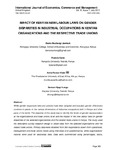| dc.description.abstract | While gender responsive laws and policies have been adapted and enacted, gender differences
continue to persist in the various dimensions of industrial occupations both in Kenya and other
parts of the world. The objective of this study was to identify the levels of gender representation
at the organizational and trade unions level and the impact of the new labour laws on gender
disparities of the selected organizations and the related trade unions in Kenya. The study used
the descriptive survey research design to obtain data from the selected organizations and the
related trade unions. Primary data were obtained from 360 respondents drawn from operational,
management and trade unions levels using interviews and questionnaires, while organizations’
records were used for secondary data. Data were summarized using percentages, ratios, frequencies and the measures of central tendency. The findings revealed that gender disparities
continue to persist in Kenyan organizations, and that many of the gender responsive policies
within the new labour laws lack the capacity to create gender balances in organizations. The
key recommendations made included the enforcement of the two third rule at all organizational
levels | en_US |

